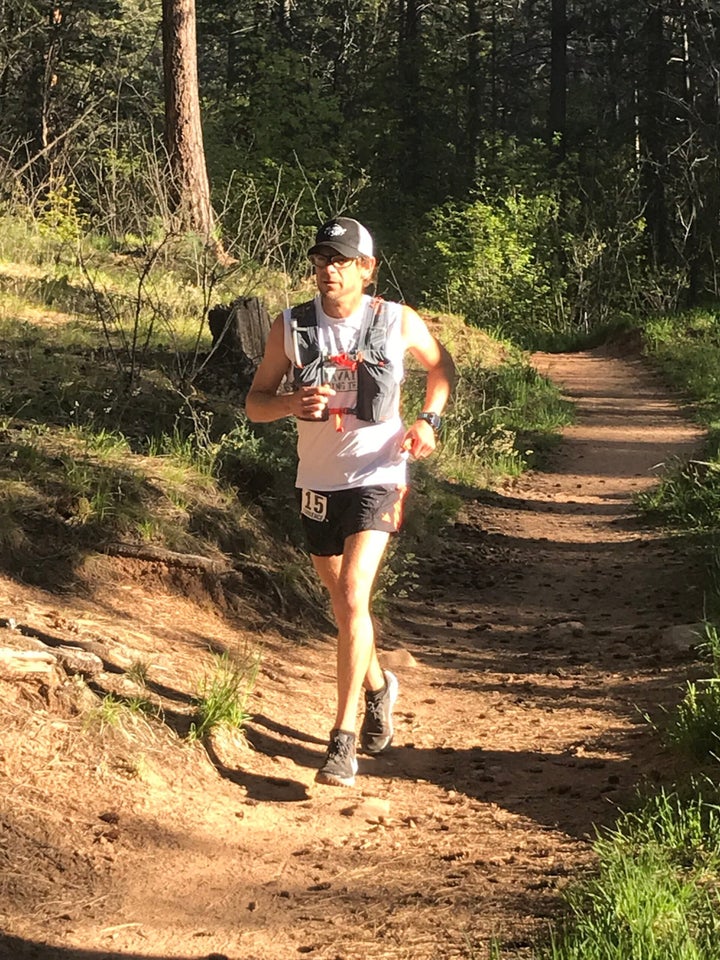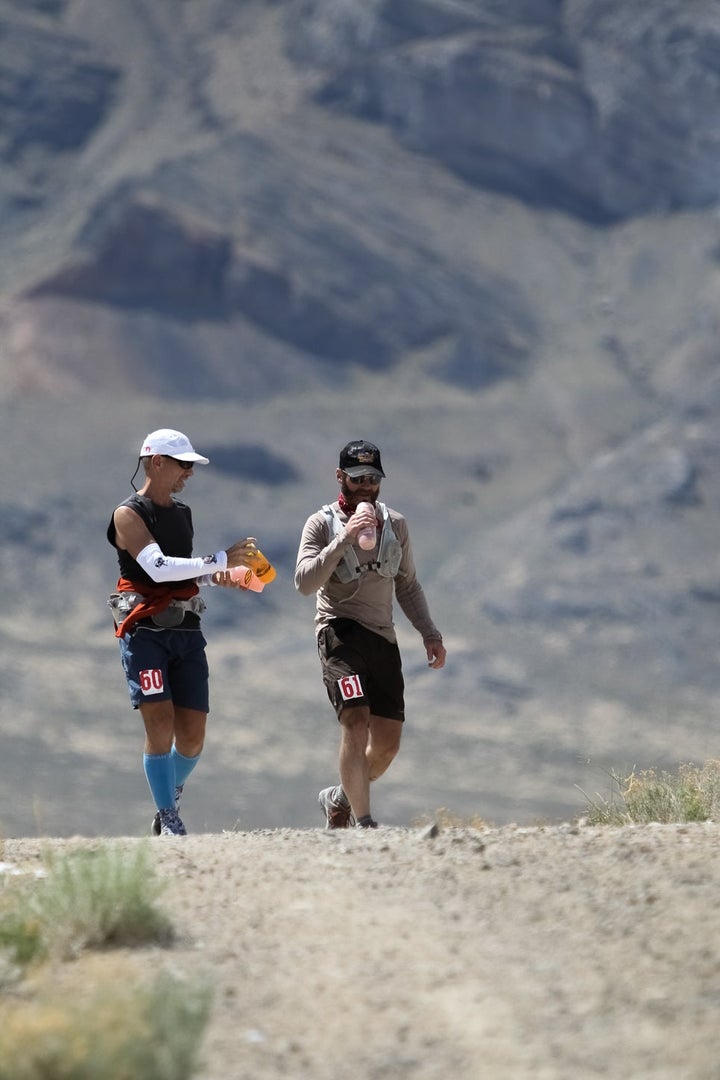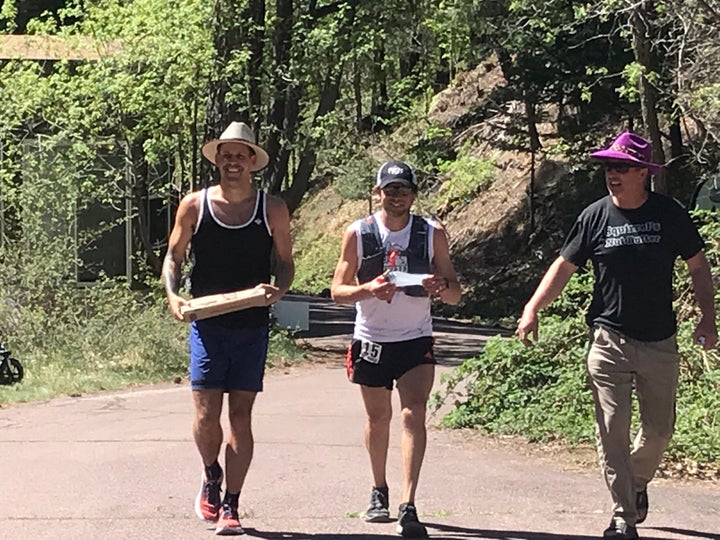Lying in the grass, I stared up though the pine branches at the white, pink, and red lined sandstone cliffs that make up the rugged Mogollon Rim, a 200-mile long 1,500 foot high escarpment that winds its way through the heart of Arizona. Too bad I was supposed to be running, not sprawled out 37 miles into this rugged mountain trail ultramarathon, the Zane Grey Highline Trail 50 Mile.
My quads were blown (I’d resorted to hiking five miles earlier just to get this point), my stomach had shut down before that, and I still had a half-marathon distance to cover with the steep climb up over the rim.

I’d run this race 14 times before, won it twice, and once held the course record. But today, I found myself chasing the cutoff—the time when race management closes the course and doesn’t let you proceed. My past self would have been finished two and a half hours ago.
So, as I lay on my back, weighty questions began to drift through my head, “Ian, why are you doing this to yourself?” And, most pointedly, “Why the heck should you crawl the last 13 miles to the finish?”
Hopelessness, like what I experienced at Zane Grey, is a common emotion among the ultrarunning crowd. We often experience it more than once during a single event, yet we muster the gumption to push forward.
A Broader Definition of Success
“Ultrarunners must have a broader definition of success because of the length, terrain, and conditions under which their events are held,” says Stan Beecham, ultrarunner, sport psychologist, leadership consultant, and author of Elite Minds. “In their world, accomplishment is tied to behavior rather than to a specific result.”
In other words, though an ultrarunner finishes a race and notches a certain time and place, that result might mean less to them than what they overcame (both physically and mentally) in order to cross the finish line. Success stems not from having avoided problems and notching a fast time—the goal of most shorter-distance racers—but from how they dealt with the inevitable problems that arise over these daunting distances.
“We live in a result-oriented culture and racing is no different,” says Beecham. “You’re immediately ranked and categorized when you finish. Successful ultrarunners can see past this.”

Beecham suggests rather than worrying about an outcome, concern yourself with the immediate—what you can do right here and now. Specifically, by overcoming the issue that’s right in front of you, only then can you take the next step.
“The danger is that many people get distracted, stuck, and can never move forward,” continues Beecham. “Think of it in terms of this: Performance is equal to your potential minus all the distractions.” If you’re preoccupied with sidetracking thoughts like how you’ll stack up against others, that you’re hiking instead of running, or your finish time will be slower than what you want it to be, you’re sabotaging your ability to do your best.
Climbing Out of a Deep Hole
Take, for example, Southern California ultrarunner Dan Burrier, who found himself in a deep, dark hole during last year’s Flagstaff to Grand Canyon Stagecoach Line 100 Mile. “I came into the 67-mile aid station in the middle of the night,” recounts Burrier. “I was cold, lonely, frustrated, and completely drained. I was cooked. A gloomy voice from within took charge and told me I wasn’t good enough to be here and all of this was pointless. I wanted to quit.”
Burrier regrouped by turning his attention to the bigger picture. “It suddenly dawned on me, I realized I was being silly—a big baby,” says Burrier. “This was but one single point, one mile, in one of many, many races. I had trained for this, I had already covered 67 miles, and I brought my wife, Lauri, and my good friend Ken all the way to northern Arizona for this race. All I had to do was keep moving forward and leave this mile behind me. So, I just stood up, put on my tights and jacket, and told the volunteers I was leaving the aid station.”
Burrier crossed the finish line the following day. “For the rest of the race I didn’t know if I’d make it,” he says. “But I was going to keep trying anyway.”

Beyond Desire: Honesty, Growth, and Love
In order to understand how success is “found,” it’s important to understand why people succeed or fail. “First off, success isn’t about desire. You’ve got to have more than that,” says Beecham. “Everyone desires success—power, fame, and/or fortune. But we all know not everyone has it.”
Beecham says successful runners all have these fundamental characteristics:
- Carry on in a businesslike manner: These athletes have a realistic and clear understanding of what they must do to train, race, and stay healthy. When faced with tough situations, they are able to logically and calmly address them and understand that they will pass.
- Recognize someone else’s as well as their own B.S.: Runners who are honest with themselves, understand their limits, and set realistic expectations can overlook social pressures and prioritize accordingly.
- Learn from their mistakes: By implementing key adjustments, like hiring a coach or improving race-day nutrition, they lower the chances of game-ending mistakes.
- Enjoy the sport: The rewards of running are primarily intrinsic and training for training’s sake is satisfying.
- Construct doctrines: As time passes and experiences grow, these runners develop a system or set of beliefs around their running that accentuates their ability to complete workouts and races. Examples include:
- “I don’t feel like running, but I know I’ll feel better once it’s done.”
- “If my run is the first thing I do every day, I’ll never miss my workout.”
- “The race will be easier to digest and less overwhelming if I take it one aid station at a time.”
- “I’ve set multiple goals for myself, so if I fall short on one, I have another to work toward.”
These tenets are the point of intersection for tenacious runners of all distances, not just those running 100 miles—from the first timer trying to finish their maiden mile to the elite marathoner bound for the Olympics. Success can be found at any distance and at any level if you have the right mindset. Ultrarunners have to adopt these perspectives simply to survive their races—other runners must embrace them in order to thrive in a sport full of issues.
Still Out There
Back below the Mogollon Rim, I realized I wasn’t ready to throw the towel in. I took some time to regroup, lower my heart rate and core temperature, and get in some much-needed calories—before my crew and aid station volunteers kicked me out.

Six miles separated me from the next aid station—a distance I’ve covered thousands of times before. When I thought about it that way, the space between where I was and where I needed to go wasn’t as daunting. So, like Burrier, I stood up, dusted myself off, and moved onward for my 15th Zane Grey finish.
Sure, I wasn’t finishing near the front as I did 20 years prior, but at least I was out there and a part of the party. I was carrying on, overcoming issues, learning and loving the sport, just as I did when I was winning the race. I wouldn’t have it any other way.
—
Ian Torrence has finished more than 200 ultras and won 53 of them. He currently serves as the national restoration director at the American Conservation Experience and coaches ultra runners and marathoners online with Sundog Running.
Michael Lebowitz captures images of ultrarunning at longrunpictures.com and is the author of Tarmac Meditations: Haiku and Photography.


